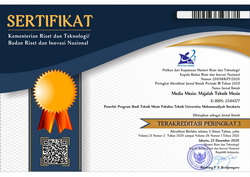STRUCTURAL AND MECHANICAL CHARACTERIZATION OF TUNGSTEN NITRIDE COATINGS PREPARED BY DC SPUTTERING AT CYLINDER LINER
Haerul Ahmadi(1*), Ihwanul Aziz(2), Dewi Lanita Sari(3), Idawati Supu(4)(1) Faculty of Mathematics and Natural Sciences, Physics Department State University of Gorontalo
(2) Accelerator Technology Research Center (PRTA) National Research and Innovation Agency
(3) Electromechanical Study Program Indonesian Nuclear Technology Polytechnic
(4) Faculty of Mathematics and Natural Sciences, Physics Department State University of Gorontalo
(*) Corresponding Author
Abstract
The cylinder liner is a tube that protects the piston and is a place for the combustion process. The combustion process causes continuous friction to make the cylinder liner wear out. Therefore the cylinder liner must be made of materials that have high hardness. To obtain a high hardness level, surface treatment with DC sputtering techniques is carried out. Surface treatment with DC sputtering technique for 120 minutes with variations of Argon gas and Nitrogen gas 70:30, 80:20, and 90:10. Based on the XRD test results, all treated samples contained a WN layer. The crystal structure of the raw material samples is hexagonal, and the crystal structure of all processed samples is cubic. Vickers hardness characterization shows that the raw material is 110.93 HV. While the sample treated with Ar70:N30 was 234.66 HV. The optimum hardness occurred in samples treated with Ar80:N20 with a hardness of 311.87 HV. However, the Ar90:N10 treatment experienced a decrease in hardness to 130.44 HV. Based on the results of thin film testing, WN affects the increase in the hardness of the cylinder liner material. This is evidenced by the increase in hardness in samples coated with WN.
Keywords
Full Text:
PDFReferences
E. Teiseran, “Teknik Motor Cara Memeriksa, Menyetel, Menganalisa Kerusakan dan Trouble Shooting,” Edisi 1., Yogyakarta: Penerbit Liberty Yogyakarta, 1999.
I. W. G. Arthana and I. M. Widiyarta, “Ketahanan Aus Lapisan Ni-Cr Pada Dinding Silinder Liner Dengan Menggunakan Powder Flame Spray Coating,” vol. 14, no. 2, p. 6, 2014.
J. S. Santner and G. M. Goodrich, “Engineered Casting Solutions : Iron Alloys,” CASTING SOURCE DIRECTORY, 2006.
E. Diniardi, S. Kirono, A. I. Ramadhan, and A. Julianto, “Analisa Kekerasan Dan Laju Keausan Blok Silinder Mesin Sepeda Motor Berbahan Paduan Al-Si,” p. 5, 2014.
S. Kirono and A. Julianto, “Analisa Sifat Karakteristik Blok Silinder Liner Bahan Aluminium Silikon,” p. 11, 2014.
H. Setiadi, “Analisis Struktur Mikro Dan Sifat Mekanik Lapisan Nicr-Al Yang Dibentuk Dengan Metode Sputtering Pada Baja St 40,” UNIVERSITAS MUHAMMADIYAH SURAKARTA, p. 26, 2018.
H. Rashid et al., “Physical and electrical properties of molybdenum thin films grown by DC magnetron sputtering for photovoltaic application,” Results in Physics, vol. 14, p. 102515, Sep. 2019, doi: 10.1016/j.rinp.2019.102515.
A. H. Abdelhameed and W. Jacob, “Deposition of thermally stable tungsten nitride thin films by reactive magnetron sputtering,” Surface and Coatings Technology, vol. 375, pp. 701–707, Oct. 2019, doi: 10.1016/j.surfcoat.2019.07.046.
E. Karyanto, “Teknik Perbaikan, Penyetelan, Pemeliharaan, Trouble Shooting Motor Diesel,” Jakarta: CV. Pedoman Ilmu Jaya, 1986.
E. Lassner and W.-D. Schubert, “Tungsten Properties, Chemistry, Technology of the Element, Alloys, and Chemical Compounds,” New York, Boston, Dordrecht, London, Moscow: Kluwer Academic / Plenum Publishers, 1998.
G. D. Rieck, “Tungsten and its compounds,” First edition., Doctor of Chemistry, Professor of Physical Chemistry Technological University of Eindhoven, Netherlands: PERGAMON PRESS, 1967.
W. Andrew, I. Kanno, H. Kotera, and K. Wasa, Handbook of Sputter Deposition Technology: Fundamentals and Applications for Functional Thin Films, Nano-Materials and MEMS, Second. USA: The Boulevard, Langford Lane, Kidlingston, Oxford OX5 1GB, UK, 2012.
A. J. Blake and W. Clegg, Eds., Crystal structure analysis: principles and practice, 2nd ed. Oxford ; New York: Oxford University Press, 2009.
Y. Wibisono, “Biomaterial dan Bioproduk,” in Biomaterial dan Bioproduk, Pertama., Malang, Indonesia: Universitas Brawijaya Press (UB Press), 2017, p. 98.
T. Setianingsih, Sutarno, and E. Masruroh, Prinsip Dasar dan Aplikasi Metode Difraksi Sinar X untuk Karakterisasi Material, Pertama. Universitas Brawijaya Press (UB Press), 2018.
Mashuri, “Ilmu Bahan I,” Edisi 1., Surabaya: ITS, 2002.
K. Herrmann, Hardness Testing—Principles and Applications. Braunschweig: ASM International, 2011.
N. H. Sari, Material Teknik. Yogyakarta: Deepublish, 2018.
H. R. Verma, “Atomic and Nuclear Analytical Methods : XRF, Mössbauer, XPS , NAA and Ion-Beam Spectroscopic Techniq ues,” Verlag Berlin Heidelberg: Springer, 2007.
ISO 6507-1, Metallic materials - Vickers hardness test - Part 1: Test method. 2018.
ASTM A247-16a, “Test Method for Evaluating the Microstructure of Graphite in Iron Castings,” ASTM International. doi: 10.1520/A0247-16A.
J. R. Rohi, P. T. Iswanto, T. Sujitno, and E. U. Kondi, “Pengaruh Sputtering Tin Terhadap Kekasaran, Kekerasan Permukaan Material Aisi316l,” politeknologi, vol. 18, no. 3, pp. 331–338, Dec. 2019, doi: 10.32722/pt.v18i3.2412.
J. S. M. Purba, “Pengaruh Perlakuan Gas Argon (Ar) Terhadap Pola Konsumsi Energi, Dan Sifat Baja Karbon Sedang Hasil Nitridasi Dengan Mengunakan Plasma Nitriding,” p. 94, 2018.
M. G. Ananda, “Deposisi TiN pada AL-5083 untuk meningkatkan kekerasan dan ketahanan korosi menggunakan Proses DC Sputtering,” STTN BATAN, 2019.
R. Kusnowo, “Analisa Uji Kekerasan dan Uji Tarik Material AISI P20 Mod. Hasil Perlakukan Hardening dan Tempering,” JTT J. Teknol. Terap., vol. 1, no. 1, Apr. 2018, doi: 10.31884/jtt.v1i1.30.
Article Metrics
Abstract view(s): 856 time(s)PDF: 523 time(s)
Refbacks
- There are currently no refbacks.








